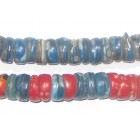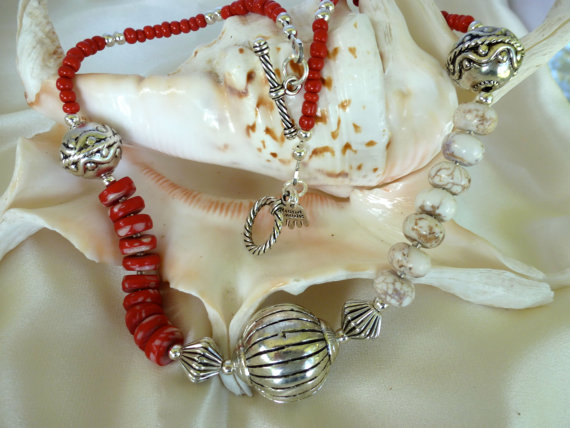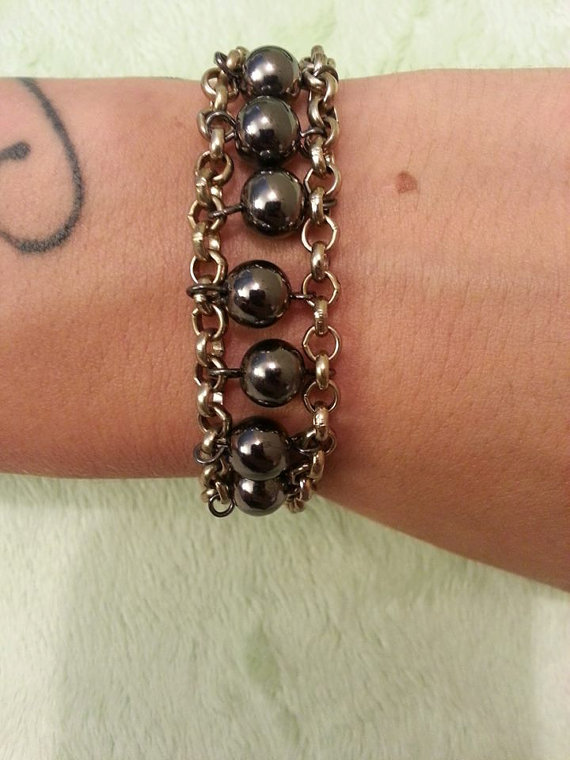3 Stylish Uses For Kakamba Prosser Beads
Prosser beads are so much more than colorful spacers. With their versatile donut shape, and myriad of two-tone color combinations, they make for beautiful focal beads whether teemed with silver chain, or wire-wrapped glass spheres. Here are a few examples which show how to incorporate them into contemporary, yet bohemian jewelry pieces.
Asymmetric Polychrome Necklace
This "Congo Kapers" necklace featured on Etsy is a classic example of how old Kakamba Prosser Beads can really give your jewelry that contemporary edge. The white of the Prosser Beads is beautifully accented by milky Howlite, a naturally occurring mineral which serves to further emphasize the marbled effect of these old trade beads. Focal silver spacers break up the a-symmetric design, creating a division between beads old and new.
Tassel Earrings
As long as tribal influences are in vogue, tassel earrings will never go out of fashion. To make them a little more visually unique and interesting, create a Prosser bead sandwich simply by threading two beads onto an eye pin, separated by a silver donut spacer in the middle. Then, create the tassels using Masaai seed beads in two colors that match your polychrome Prossers. To finish, simply attach to a fish hook ear-wire.
Dual Chain Bracelet
Chunky wrist adornments are bang on trend at the moment, and because of their size, Prosser beads make for great focal beads with this particular design. You'll need two matching strips of silver or bronze chain slightly shorter than the circumference of your wrist, coupled with approximately 11-13 Prosser beads in one color. Using eye pins, simply create a ladder of beads between the two chains, leaving a little room at each end for the bolt ring and clasp. This example from The Mad Lila at Etsy gives you an idea of the end result.
The Rise and Decline of Kakamba Prosser Beads

Red and Blue Kakamba Prosser Beads
The journey of a bead collector is one filled with ponderings and questions. Where do my Trade Beads come from? Who made them? Even if these tiny details don't mean much to you personally, they can have significant bearing upon your authority and commercial appeal as a jewelry artist.
Kakamba Prosser Beads are one of my most recent discoveries. I actually happened upon them whilst looking for some colorful spacers to use in my jewelry. Early Prosser Beads were named after English brothers Richard and Thomas Prosser, who devised the innovative molding technique for their production in 1840. The rights for this technique were later bought by Jean-Felix Bapterosses, a French button manufacturer who would later found one of the largest bead-producing factories in Europe. Sometime in the 1860s, Prosser Beads came to be known as “Kakamba Prosser Beads”; named after a small town in The Republic of the Congo where they were traded by merchants.
According to trade records, Africa was one of the chief markets for Prosser Beads. European traders would use them to build rapports with tribal chiefs, thus ensuring safe passage through unexplored or unknown regions. However, these merchants were shrewd types, and weren't averse to conning tribespeople in order to get what they wanted. Beads were often strung upon weak cord, which would break easily. Natives were also told it was bad luck to pick them up, thus creating a need for new beads in exchange for small favors.
Prosser Beads continued to be produced in Europe long after the death of Jean-Felix Bapterosses in 1885, however, largely fell out of favor as more elaborate beads were introduced to Africa in the early 1900s. Their sad decline in popularity eventually relegated them to the history books by the mid 20th Century – until locals in Kakamba began finding hoards of them in the ground while farming.
To think that the beads I hold today once traveled 3,000 miles from Europe to the Congo is amazing, but more fascinating still is the fact they may once have adorned the neck of a great tribal chief all those years ago. A slice of history being recycled once more for self adornment!

